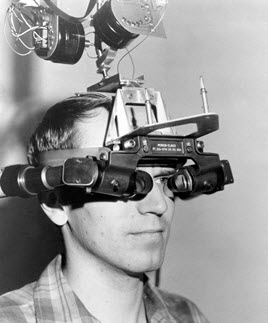
I have been involved in developing, evaluating and selecting tools and methods for field service and failure diagnostics in complex equipment for many years. Among the many technologies, virtual reality (VR), the technology that was heralded and then flopped in the 90s, seems to stage a comeback, thanks to significant improvement in hardware and visualization technologies, and eye-catching products like Google Glass (discontinued earlier this year), Oculus Rift (acquired by Apple in 2014) and Microsoft’s Hololens. A client sent me links to articles on virtual reality that appeared in a recent issue of The Economist and asked for an opinion.
The longer article, titled Grand Illusions, offers some historical perspective and discusses numerous opportunities for virtual reality applications, mostly related to gaming and gaming-like areas. The article cautions readers to “curb your enthusiasm”, citing multiple technology, human physiology and social barriers.
The other, much shorter, The Economist summarizes the state of VR: “VR today is where smartphones were in 2001. Back then it was clear that mobile phones, connected to the internet and armed with cameras and colour screens, were going to be important. Sure enough, people now use phones for everything from maps and music to payments and picture-sharing. But the strongest advocates of the smartphone revolution, such as Nokia, failed to anticipate how it would play out, with the result that others now dominate the new industry. The turning-point was Apple’s iPhone. With its touchscreen and elegant apps, it set the model for the entire industry. VR has yet to have its iPhone moment. The idea is sound and the gear works, but today’s chunky headsets are unlikely to conquer the mass market.”
Virtual Reality in Field Service
What about the application of VR technology to assist field service technicians?
While the use of virtual reality and augmented reality (AR) to assist field service technicians seems logical and “natural”, the focus on wearable devices simulating an immersive 3D environment is somewhat misplaced. Field service technicians and, similarly, assembly line workers, are very good in following schematics and two-dimensional pictures and illustrations. They seldom need information of the kind often demonstrated in virtual reality tool presentations: “mount the part here” or “turn the wrench this way.”
This is not to say that service technicians will not benefit from improved diagnostic and service aids.
Technicians need information that incorporates the most recent organizational knowledge in a way that is task-specific and equipment-specific. That is, it is tailored to the “as maintained” configuration of the equipment being worked on and organized to according to the tasks to be performed: troubleshooting, remove-and-replace, and verification. By and large, this type of information does not benefit from VR technology, especially because the freshness of the information is more important than visual pizazz.
There are exceptions to the rule, of course, but these aren’t sufficient to drive the adoption of VR technology in most mainstream field service organizations.
On the other hand, virtual and augmented reality technology is very useful in training the field force.
The field service industry has been experiencing a steady decline in workforce due to an aging population and continued egress of experienced service technicians. At the same time, the interest of the younger workforce in field service positions is lukewarm, and service organizations struggle to attract and train service technicians.
Organizations that have not made the right investments in hiring and training find it increasingly difficult to allocated workforce effectively. In additional to facing chronic shortage of qualified technicians, service organizations struggle to optimize the allocation of their scarce resources. Lacking cross-product knowledge and certifications, highly qualified technicians are very busy and have to travel longer and more frequently, while others sit idle waiting for the next service call.
These organization should consider the use of AR and VR to provide both routine and just-in-time training, especially in instances in which training on actual equipment is difficult, costly, or potentially dangerous. The fact that game-like simulation can be very appealing to young workers does not hurt either.
The Economist proclaims “for the time being, VR remains a promising technology, worth watching closely, but still in a primitive incarnation.” VR and especially AR will slowly become part of service lifecycle management, especially as technology vendors offer more means to convert PLM information directly to virtual reality presentations.
But don’t let these eye candies distract you from your mission: make service technicians more productive.
(Photo: The first head-mounted virtual reality and augmented reality display invented by Ivan Sutherland at the University of Utah in 1968. It was referred to affectionately as the “Sword of Damocles” because it was suspended from the ceiling above the user’s head. Source: ACM)
